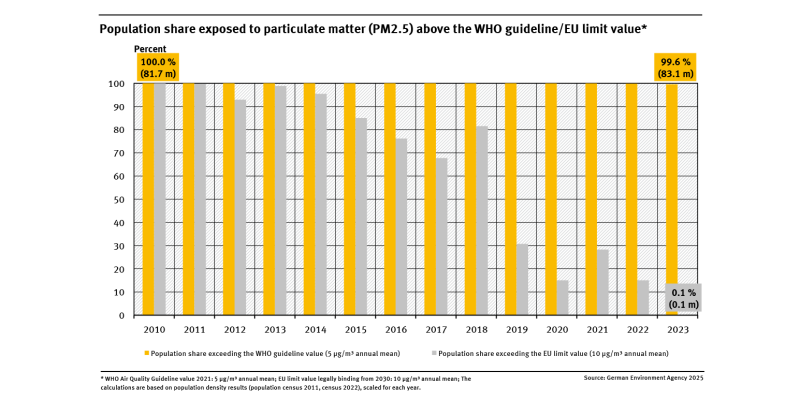Indicator: Population exposure to particulate matter (PM2.5)
 Click to enlarge
Click to enlargeSource: German Environment Agency Figure as PDF
 Umweltbundesamt
Umweltbundesamt
 Click to enlarge
Click to enlarge
- The proportion of the population exposed to annual average PM2.5 concentrations above 10 µg/m³ (the EU limit value legally binding from 2030) has decreased significantly in Germany since 2010.
- However, between 2010 and 2023, nearly the entire population was exposed to fine particulate matter concentrations exceeding the current WHO guideline value for PM2.5 (5 µg/m³ annual average).
- Therefore, further measures to reduce fine particulate pollution are necessary to protect population health.
Particulate matter (PM) in ambient air is harmful to human health. The particles enter the human body through the respiratory system. Depending on the size of the particles, they can penetrate deeply into the respiratory system. Particularly small particles can enter the blood stream when penetrating the pulmonary tissue. There is clear evidence that particulate matter can trigger various diseases (see 'Particulate matter').
PM is primarily generated by human activities, such as combustion processes or mechanical wear (e.g., tire and brake abrasion from motor vehicles). Part of PM forms in the atmosphere through chemical reactions of gaseous air pollutants (such as nitrogen oxides and ammonia) and is therefore referred to as “secondary” particulate matter.
The indicator reflects the average annual PM2.5 exposure in Germany based on data from monitoring stations located in rural and urban background areas. Monitoring stations situated in areas with high traffic volumes or near large industrial facilities—where pollution levels are typically higher—are not included. As a result, the indicator may slightly underestimate the actual exposure levels in Germany.
Between 2010 and 2023, nearly the entire population of Germany was exposed to PM2.5 concentrations above the current WHO guideline value (5 µg/m³ annual average). The number of people affected in Germany increased slightly from 81.7 million to 83.1 million during this period—solely due to population growth. At the same time, the number of people exposed to PM2.5 levels above the EU limit value (10 µg/m³ annual average), which will become legally binding from 2030, decreased significantly—from 81.7 million in 2010 to just 0.1 million in 2023 (approximately 0.1% of the population). This demonstrates that emission reduction measures in recent years have already led to a substantial decrease in particulate matter pollution in Germany.
A further decline in pollution levels is expected by 2030 as a result of the emission reduction commitments under the NEC Directive. If the measures outlined in national air pollution control programs are implemented (in Germany, for example, the coal phase-out, reduction of ammonia emissions from agriculture, and the transition to sustainable transport including e-mobility), emissions of particulate matter and its precursor gases can be further reduced by 2030. However, to better protect population health, more ambitious measures are needed—also at the European level—to further reduce particulate matter pollution.
In December 2024, the revised European Air Quality Directive entered into force. Under this directive, stricter limit and target values will be legally binding across Europe starting in 2030. For PM2.5, the new EU limit value legally binding from 2030 will be lowered from 25 to 10 µg/m³ (annual average), corresponding to the interim target 4 of the WHO recommendations.
For this indicator, data from the chemical transport model REM-CALGRID are combined with PM2.5 measurement data from the air quality monitoring networks of the German federal states and the German Environment Agency (UBA), and applied across the area of Germany. Only monitoring stations that are not directly influenced by local PM emissions—such as those from traffic—are considered. The PM2.5 data are then combined with spatial information on population distribution. The methodological approach is described in detail in the scientific article by Kienzler et al. 2024 (in German, abstract in English).
Detailed information on this topic can be found in the data article ‘Bedeutung der Feinstaubbelastung für die Gesundheit’ (in German only).